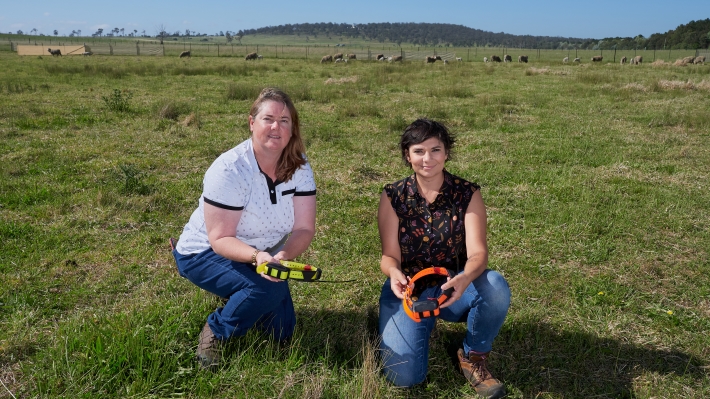Joint UNE and CSIRO post-doctoral researcher Danila Marini and joint UNE/CSIRO PhD candidate Tellisa Kearton are wrapping up a series of complex experiments that have tested and measured sheep stress responses to virtual fencing, as well as its effectiveness for managing intensive, rotational grazing.
Danila has discovered that sheep eat the same amount of food, in much the same way as if contained by electric fencing. "They behave normally, graze normally, without any stress, and learn very quickly how to interact with the fence," she says.
A virtual fence is an invisible line in the landscape that can be created on a map on a tablet, and moved or erased at the farmer's touch. Animals wearing a GPS-enabled neckband are warned of the presence of the invisible “fence” through an audio cue and then, if the beep is ignored, the collar delivers a short, mild electric pulse.
A commercial version of the neckband is currently being tested in the beef industry in NSW and Queensland, but the sheep industry is lagging a little behind. Danila and Tellisa hope their findings may expedite the development of an automated neckband for sheep.
Tellisa's comparative experiments explored how sheep respond physiologically and behaviourally to the audio and electrical stimuli. Combining video analysis and measurements of cortisol levels and body temperature, she found that sheep were more stressed by a barking dog than the fence's beep. Similarly, the restraint associated with crutching or shearing was more stressful than the electrical pulse they received if they tried to breach a virtual fence.
"Once the sheep recognise that the beep indicates the boundary, it's no more problematic than any other fence, and that's been an important finding," Tellisa says. "It's very similar to the principles of a normal electric fence, except that it is an audio barrier rather than a visual, physical one."
Tellisa also discovered that sheep learn to interact with a virtual fence very quickly - after about three interactions, over a day or two and that social learning is possible. "We think individual ewes may be able to teach their lambs how to interact safely with the virtual fence, and while this maternal learning warrants more investigation, it has applications for when and how a farmer implements fencing within a mob," she says. "It may, for example, be better to introduce the virtual fences immediately after lambing, to educate the lambs all together."
The UNE research has been supported by the Rural R&D for Profit program run by the Federal Department of Agriculture, Water and the Environment, with investments by livestock industry research agencies, several universities (including UNE), CSIRO, and Agersens, the company commercialising the technology. Now, the Grains Research and Development Corporation and Australian Wool Innovation are also interested in seeing the research continue.
"This is exciting new technology that appears to be welfare-friendly," Danila says. "Cost-benefit analysis by the University of Melbourne is also showing that virtual fencing cuts the costs of permanent infrastructure while retaining the benefits of time-limited grazing systems often with improved productivity and reduced labour."
Tellisa received a three-month extension to her scholarship from UNE, in order to complete her thesis during trying COVID conditions.


